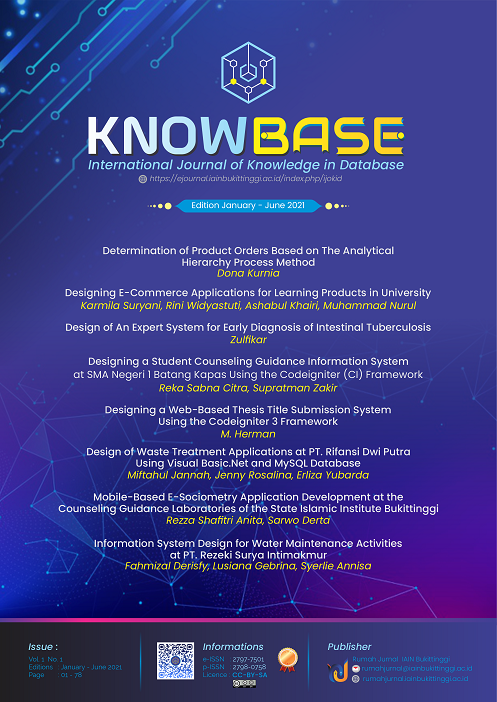Determination of Product Orders Based on the Analytical Hierarchy Process Method
DOI:
https://doi.org/10.30983/ijokid.v1i1.5039Keywords:
Determination, Product Order, AHPAbstract
Decision-making in determining product orders is a method that managers can use to determine the type of product to be ordered again based on previous sales. Product orders to be reordered will be determined based on the highest number of sales among similar products. One of the methods that can be used is the AHP method, where the AHP method can assist managers in making decisions by providing a sequence of decision alternatives accompanied by a percentage on each alternative. The research method used in this journal is the system development life cycle (SDLC) which can describe the activities in this research in detail. The application of product orders with the AHP method will be applied to a case, namely an order for clothing products at a well-known clothing outlet in Bukittinggi. The product order system will be implemented into an application designed with the Visual Basic 2010 programming language and MySQL database to make it easier for managers to make decisions. With this research, it is hoped that it can help store managers in making decisions for determining clothing orders so that they can produce the best decisions that can provide benefits in the business that is being undertaken.
References
R. Rachman, “Penerapan Metode Ahp Untuk Menentukan Kualitas Pakaian Jadi Di Industri Garment,†J. Inform., Vol. 6, No. 1, Pp. 1–8, 2019, Doi: 10.31311/Ji.V6i1.4389.
D. Dewi Yohana Br Ginting, “Sistem Pendukung Keputusan Pemilihan Baju Tunik Wanita Berbadan Gemuk Menggunakan Metode Ahp,†Kaji. Ilm. Inform. Dan Komput., Vol. 1, No. 5, Pp. 218–227, 2021.
Awaliah Nur Ajny, “Sistem Pendukung Keputusan Pemilihan Lipstik Dengan Analytical Hierracy Process,†Vol. 2, No. 3, Pp. 1–13, 2020.
E. Darmanto, N. Latifah, And N. Susanti, “Penerapan Metode Ahp (Analythic Hierarchy Process) Untuk Menentukan Kualitas Gula Tumbu,†Simetris J. Tek. Mesin, Elektro Dan Ilmu Komput., Vol. 5, No. 1, P. 75, 2014, Doi: 10.24176/Simet.V5i1.139.
A. Kusaeri, M. Hermansyah, And H. Bashori, “Analisis Pemilihan Supplier Menggunakan Pendekatan Metode Analitychal Hierarchy Process Di Pt. Xx,†J. Knowl. Ind. Eng., Vol. Vol. 3, No. 3, Pp. 51–61, 2016.
D. Fitri Hanung Wibowo, “Sistem Pendukung Keputusan Pembelian Handphone Dengan Metode Analytical Hierarchy Process,†Maj. Ilm., Vol. 8, No. 1, Pp. 1–9, 2016, [Online]. Available: Https://P3m.Sinus.Ac.Id/Jurnal/Index.Php/Tikomsin/Article/Download/73/1.
D. Rama Bangkit Ramadhon, “Analisis Pemilihan Supplier Bahan Baku Menggunakan Metode Ahp (Analytical Hierarchy Process) Dan Topsis (Technique For Order Preference By Similarity To Ideal Solution) Pada Rockmantic Store Konveksi,†Rekavasi, Vol. 9, No. 1, Pp. 54–64, 2021.
F. Maulana And D. Meidelfi, “Sistem Pendukung Keputusan Memilih Tiket Pesawat Dengan Menggunakan Metode Ahp,†J. Teknol. Inf. Indones., Vol. 5, No. 1, Pp. 1–6, 2020, Doi: 10.30869/Jtii.V5i1.510.
J. S. D. Raharjo And E. Asmelita, “Sistem Pendukung Keputusan Pemilihan Susu Formula Untuk Bayi Menggunakan Metode Topsis,†Vol. 3, No. 2, Pp. 1–8, 2021.
M. Yanto, “Sistem Penunjang Keputusan Dengan Menggunakan Metode Ahp Dalam Seleksi Produk,†J. Teknol. Dan Sist. Inf. Bisnis, Vol. 3, No. 1, Pp. 167–174, 2021, Doi: 10.47233/Jteksis.V3i1.161.
Downloads
Published
How to Cite
Issue
Section
Citation Check
License
Authors who publish with this journal agree to the following terms:
- Authors retain copyright and grant the journal right of first publication with the work simultaneously licensed under a Creative Commons Attribution License that allows others to share the work with an acknowledgment of the work's authorship and initial publication in this journal.
- Authors are able to enter into separate, additional contractual arrangements for the non-exclusive distribution of the journal's published version of the work (e.g., post it to an institutional repository or publish it in a book), with an acknowledgment of its initial publication in this journal.
- Authors are permitted and encouraged to post their work online (e.g., in institutional repositories or on their website) prior to and during the submission process, as it can lead to productive exchanges, as well as earlier and greater citation of published work (See The Effect of Open Access).



